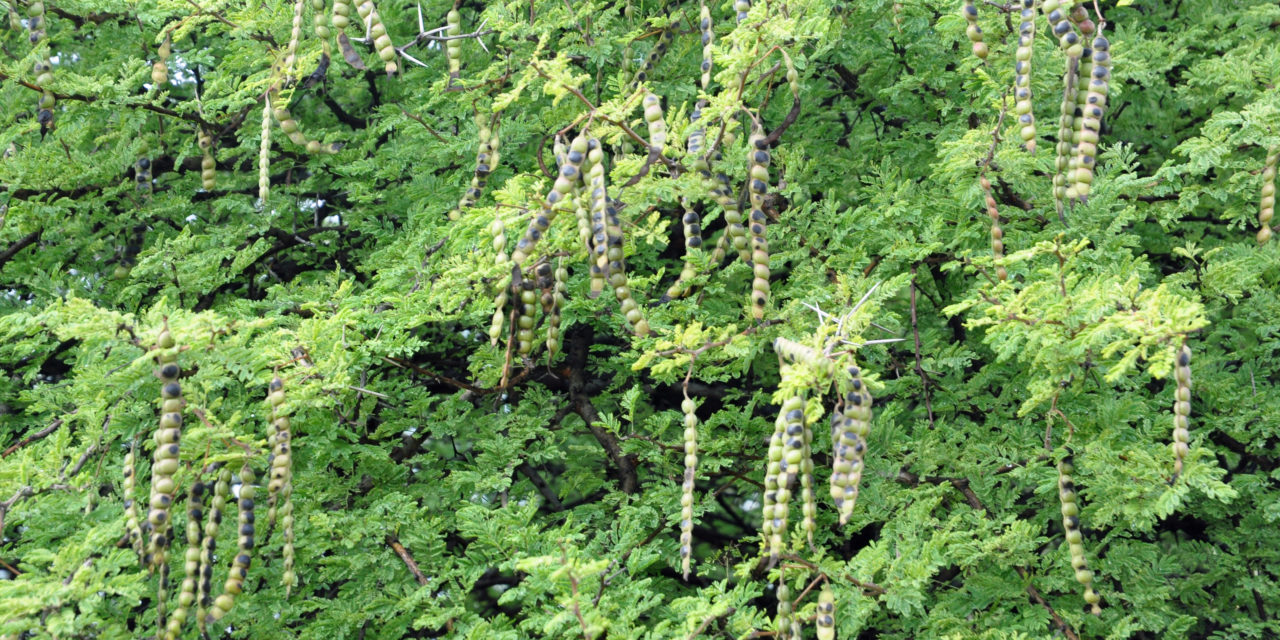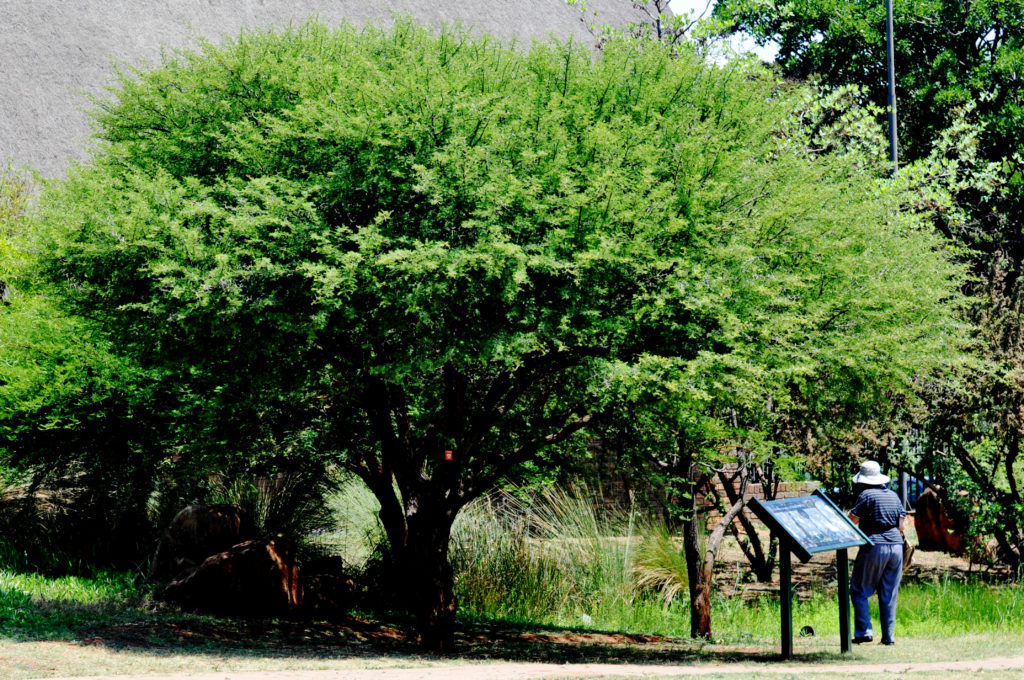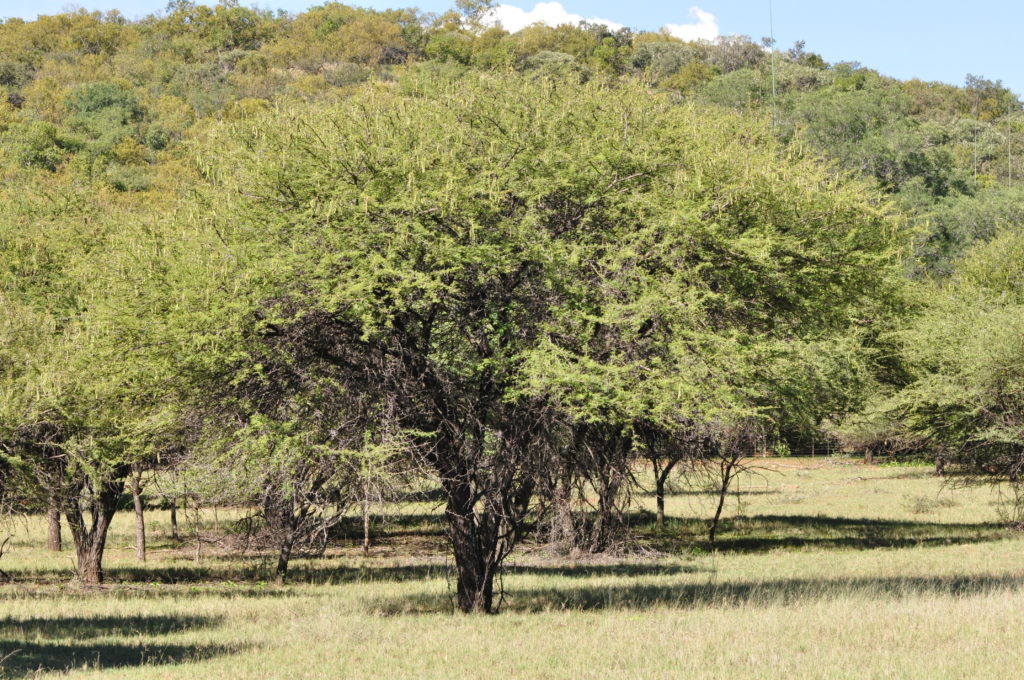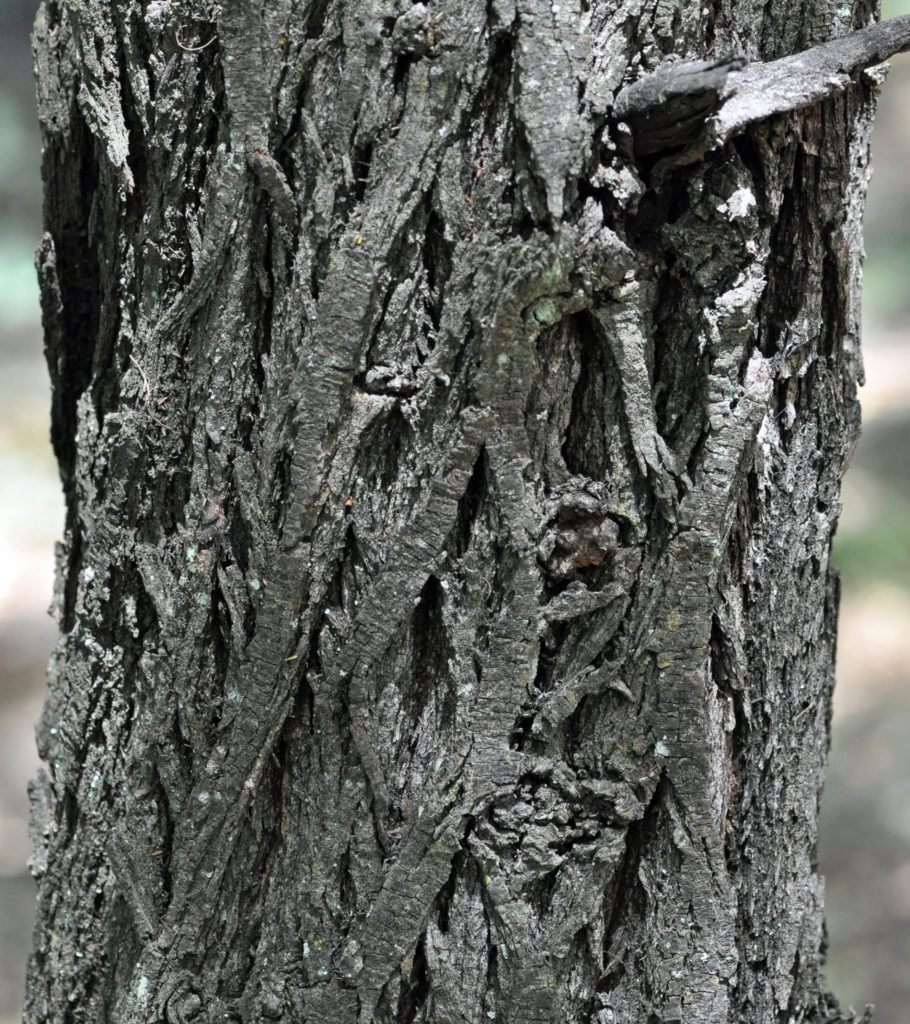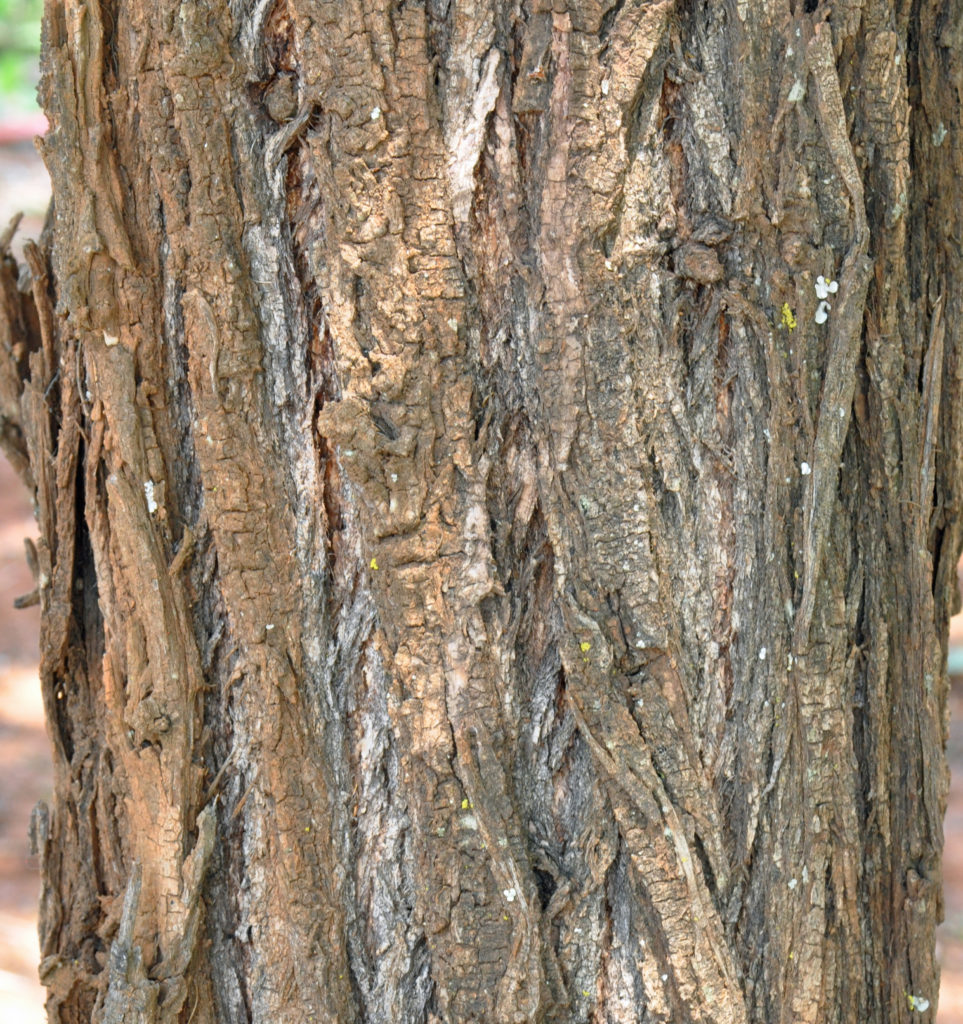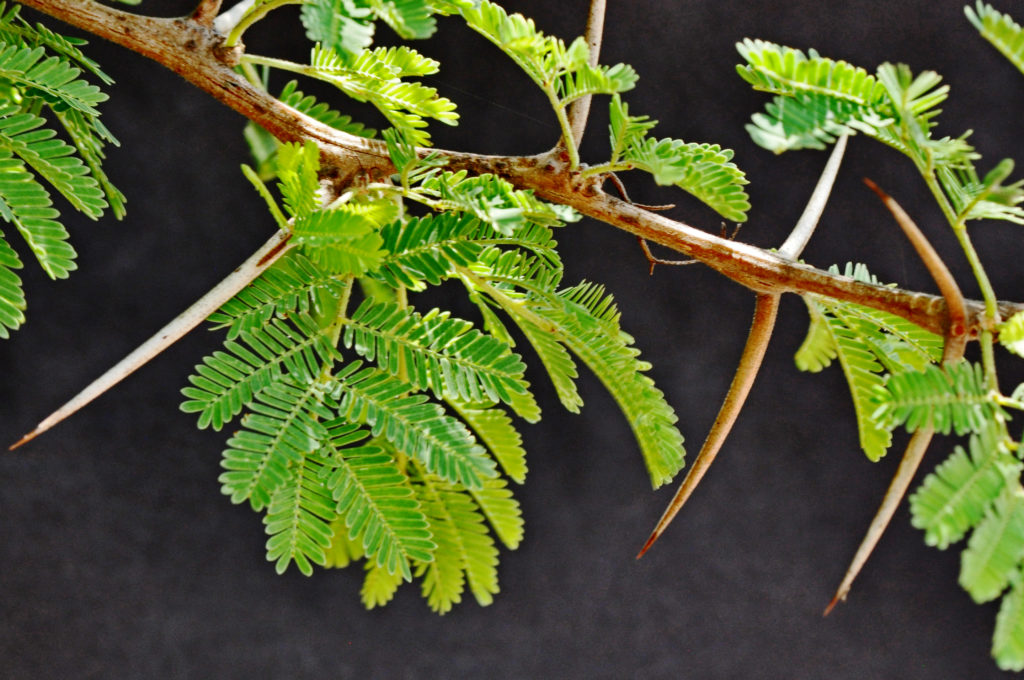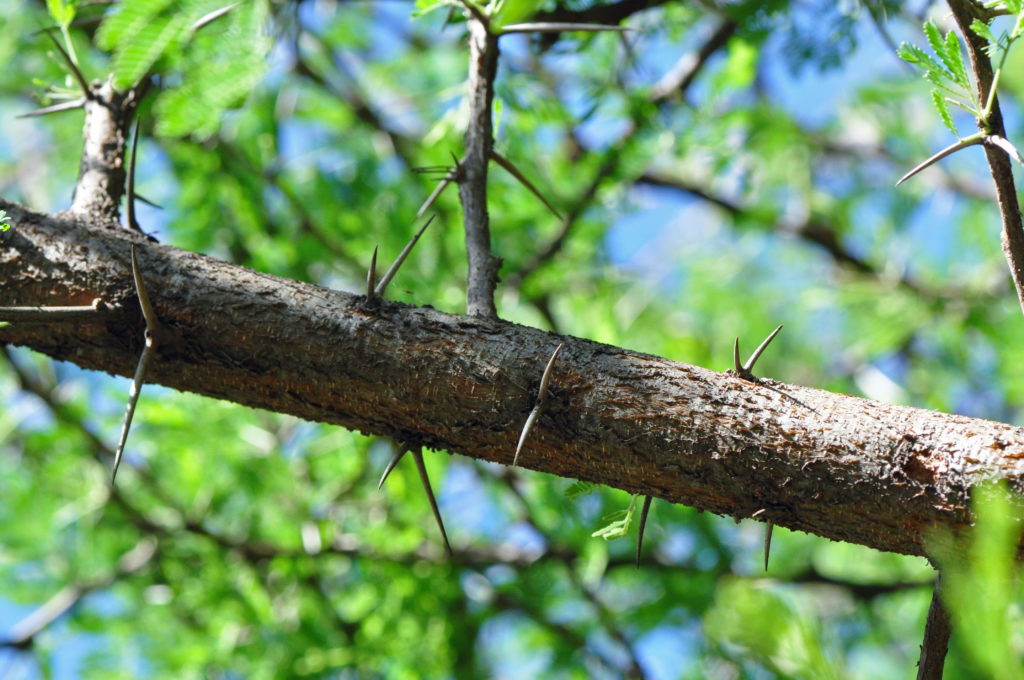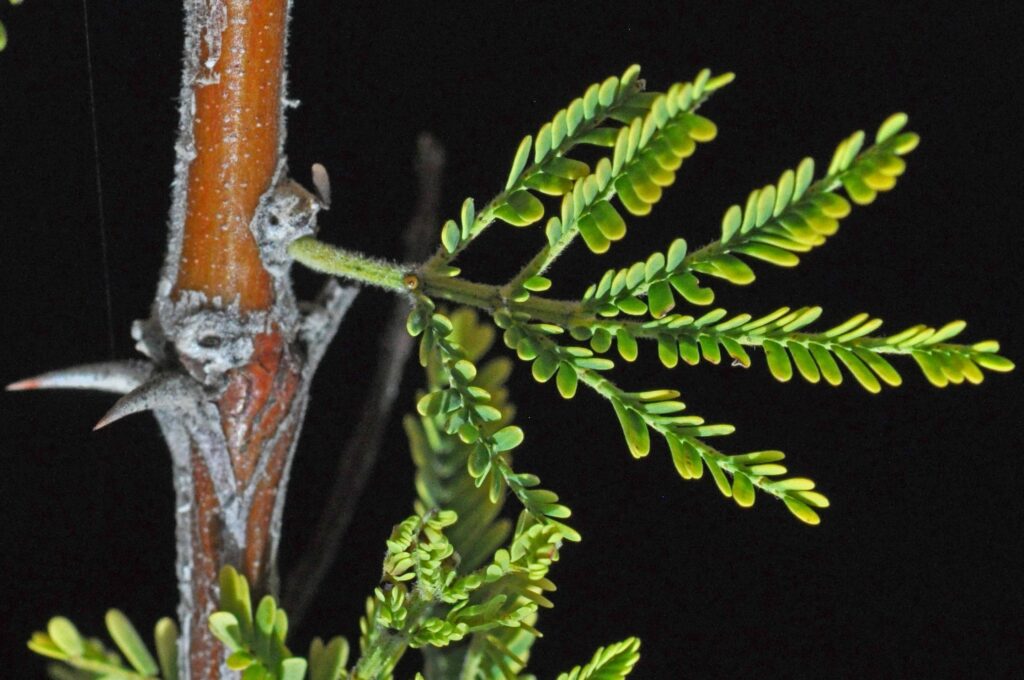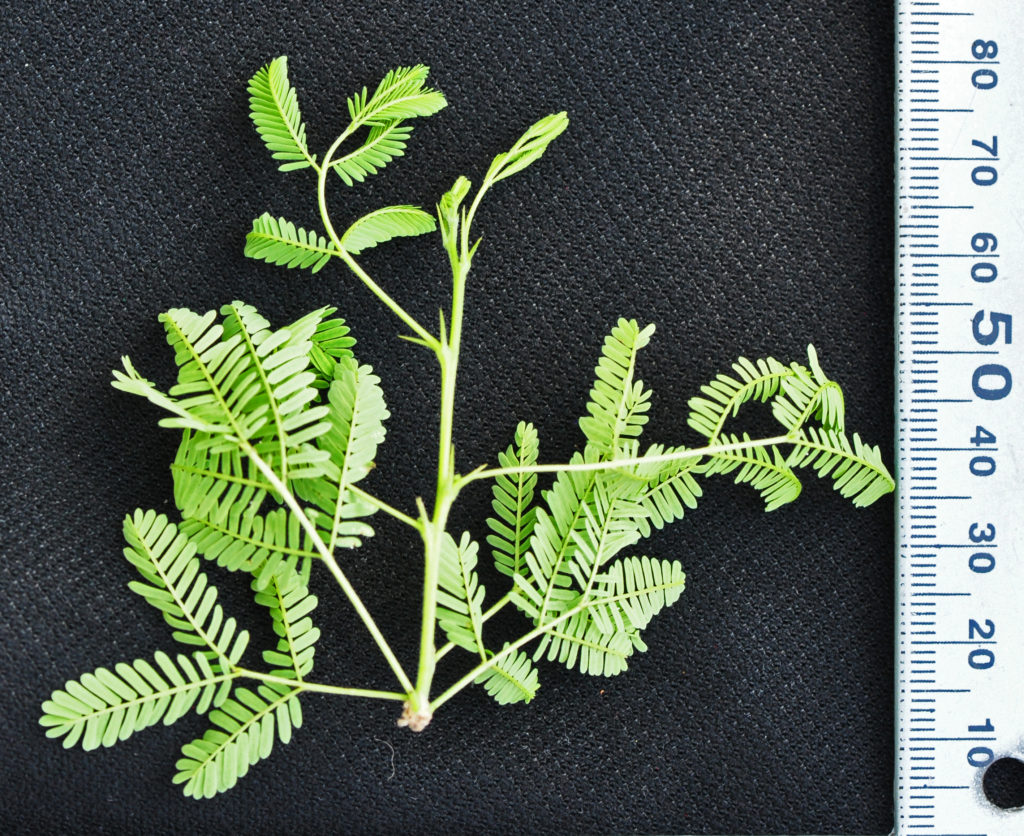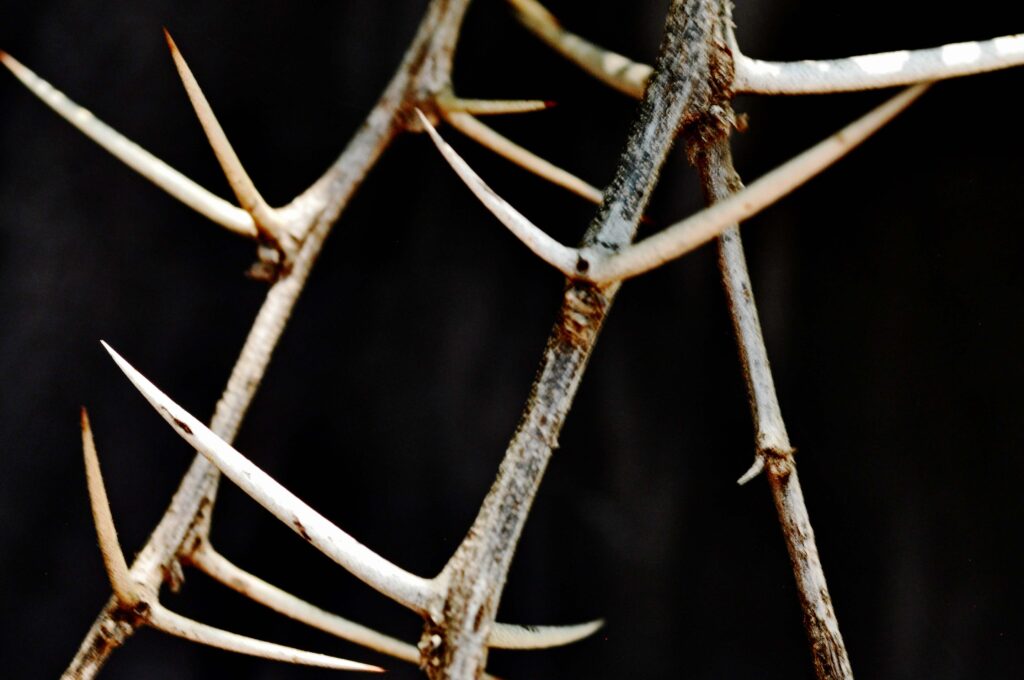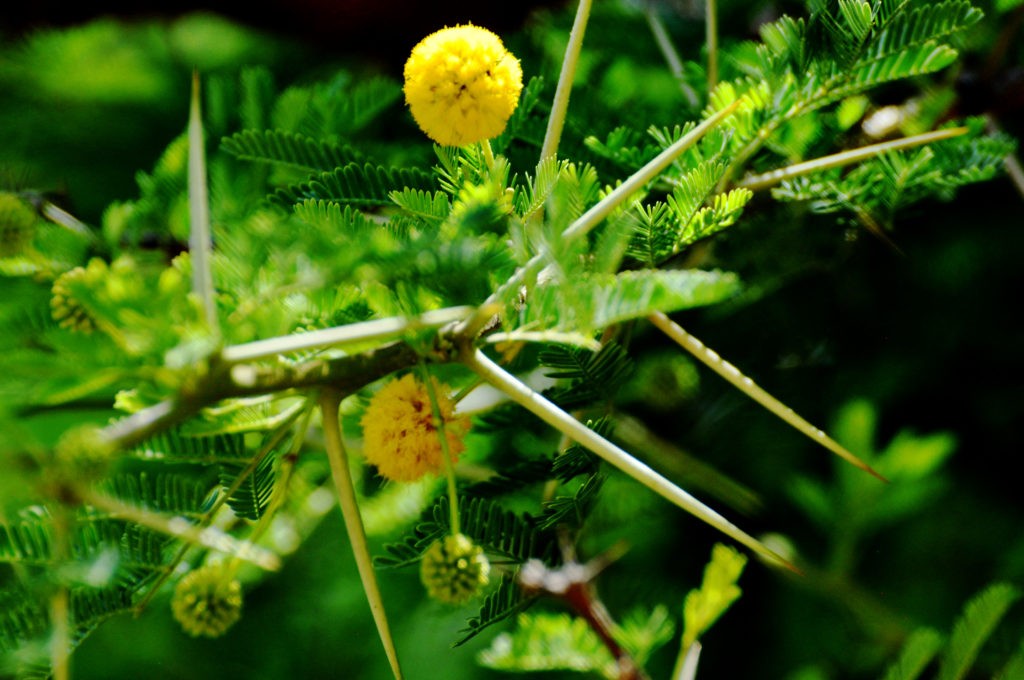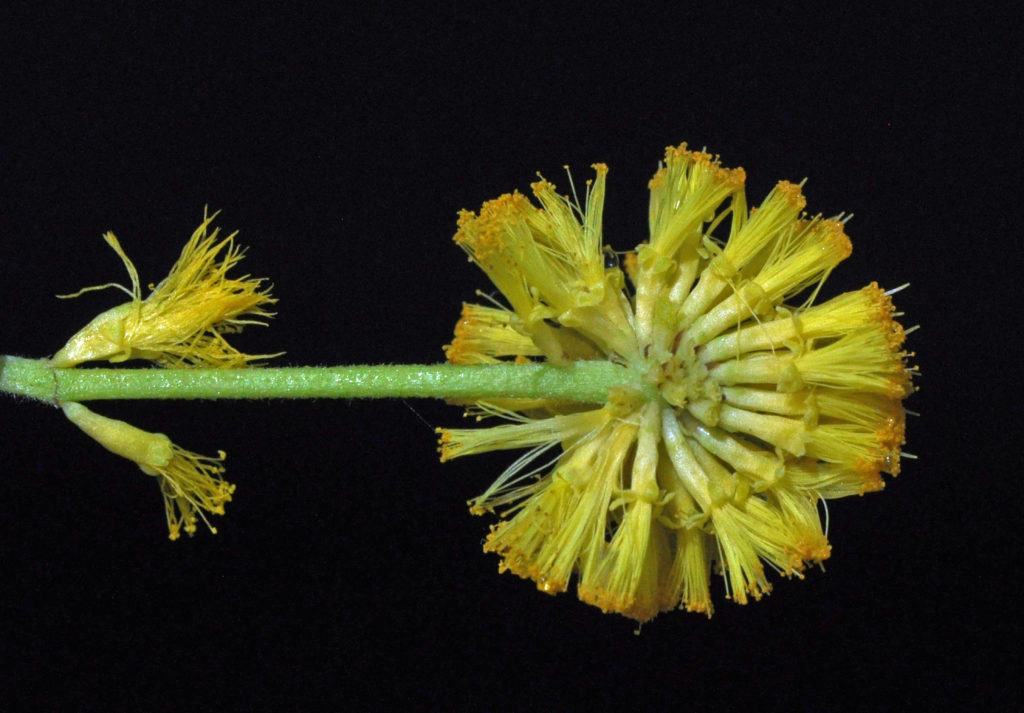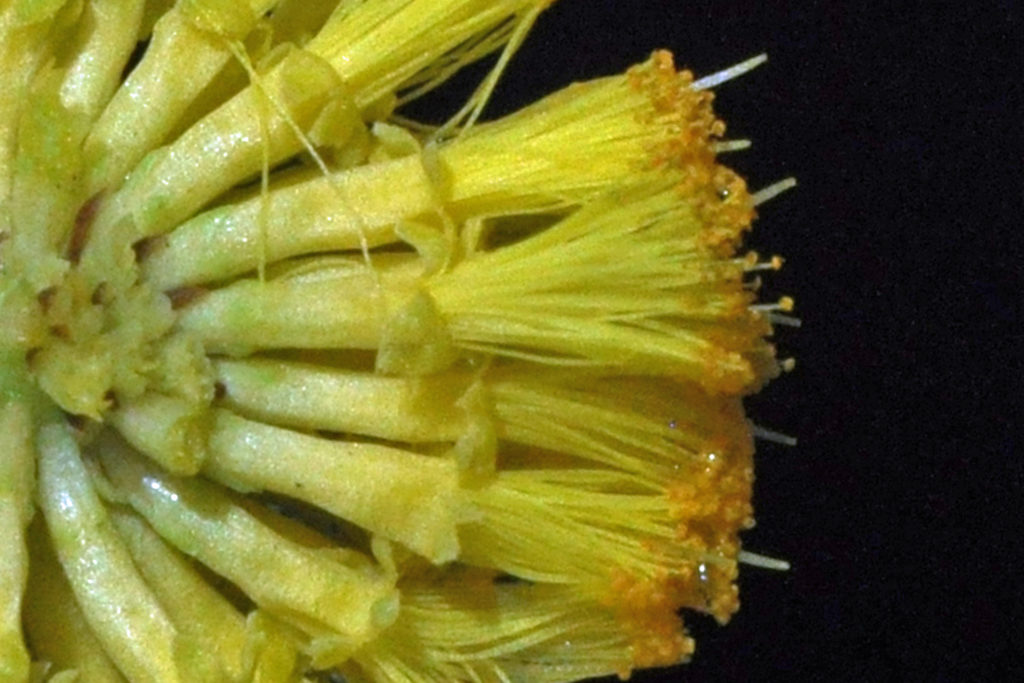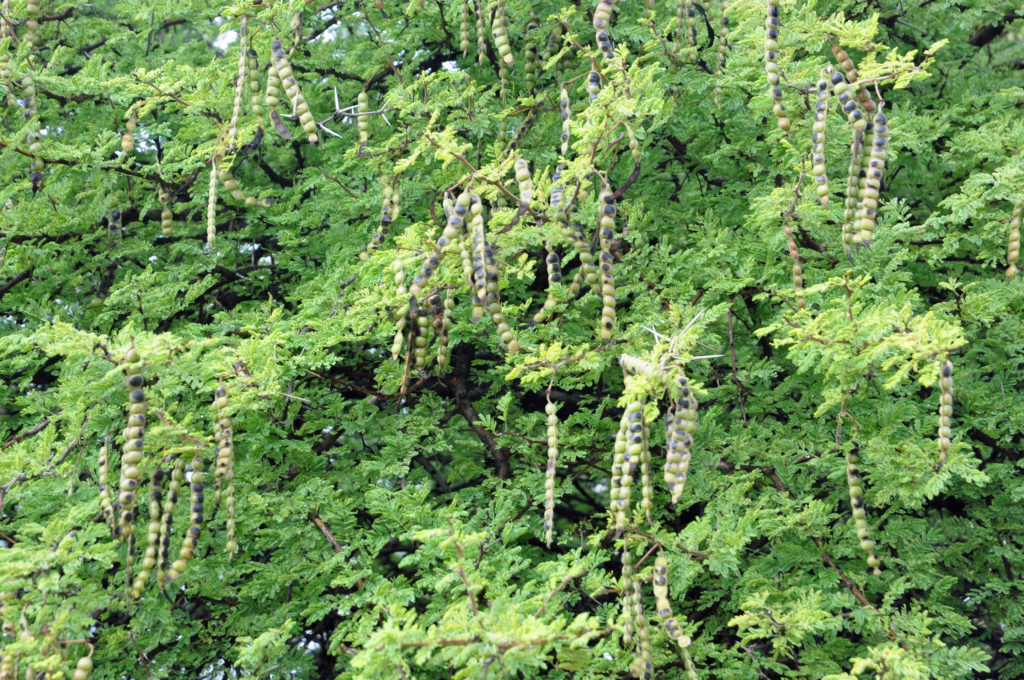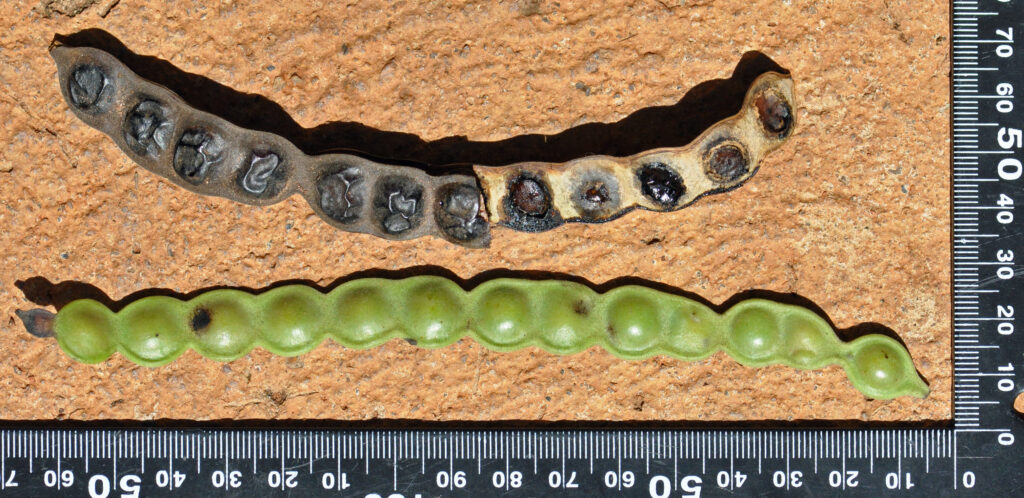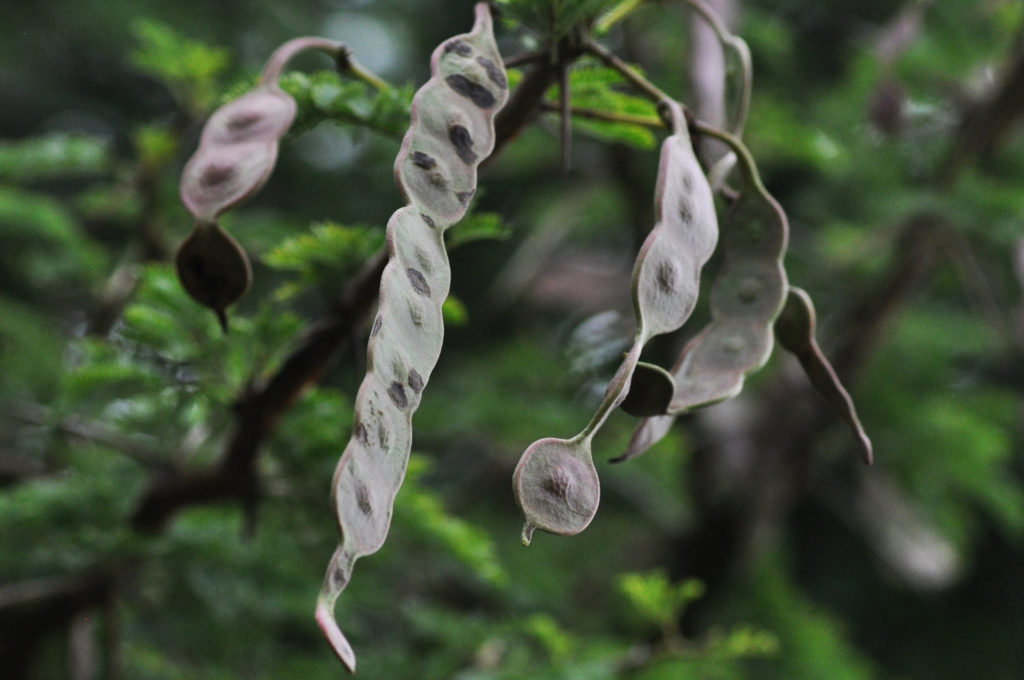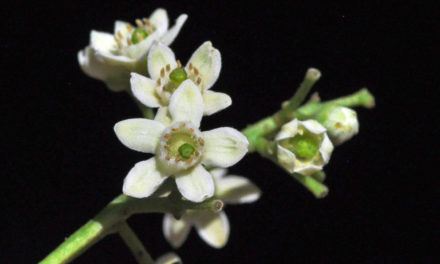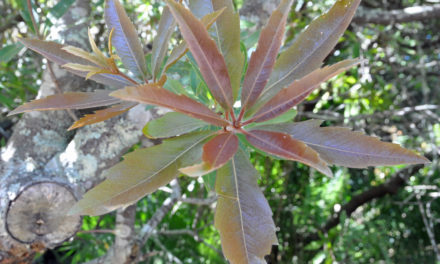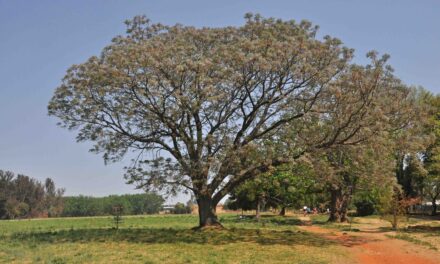General Info – summary
This Tree with its straight, tough, deeply fissured, mature bark is usually up to 6m high. The small bipinnate Leaves have paired spinescent stipules. Small golden Flowers in condensed spikes with attractive, exserted golden yellow stamens. The single pistil has a superior ovary + extending style. Pendulous Fruit is a sweet pod, constricted between seeds that are dispersed after the pods fall and break up into single seeded parts.
Description
Vachellia nilotica subsp. kraussiana
Previous Names: Acacia nilotica subsp. kraussiana, Acacia arabica, Mimosa nilotica.
SA Tree No. 179.
Common names: (Afr) Lekkerruikpeul, Ruikpeul, Snuifpeul, Stinkpeul, Swart-peuldoring, Swartsaadpeul. (Eng) Black Thorn, Red-heart Thorn-tree, Scented Pod, Scented-pod Acacia, Scented Pod thorn, Scented Thorn. (Northern Sotho) Mogohlo, Moku, Motshe. (siSwati) Inshakwe, Sitfwetfwe, Umncawe. (Setswana) Moga, Mokhi, Motsha, Motshi, Motlhabakgôsi, Mooka. (isiZulu) Umnqawe. (Xitsonga) Nxangwa.
Family: Fabaceae, or Leguminosae (Pea, bean or legume family). After the Orchidaceae and the Asteraceae, the Fabaceae is the third largest Angiosperm (flowering plants) family with 700+ genera and close to 20 000 species. Local Tree genera on this website include Acacia (Vauchellia, Senegalia), Albizia, Bauhinia, Bolusanthus, Burkea, Calpurnia, Colophospermum, Cordyla, Cyclopia, Dichrostachys, Erythrina, Erythrophleum, Faidherbia, Indigofera, Mundulea, Peltophorum, Philenoptera, Piliostigma, Schotia and Xanthocercis. The Fabaceae are recognisable by their fruit and by their pinnately compound Leaves. Leaves may also be simple – even bilobed and usually have stipules – some of which may be spinescent. Leaflets are usually entire. Flowers are bisexual and bracteate. Regular flowers usually have 4-5 sepals and the same number of petals. Irregular flowers have 4-5 sepals and 5 or less petals. Stamens have anthers that have 2 pollen sacs and there are usually at least twice the number of stamens as petals – often 10. The superior Ovary has 1 locule containing 1 or more ovules. The Stigma and Style are simple. The single carpel develops into the Fruit, which is usually a pod. The mature pods may dehisce or break into segments. Seeds vary.
Name derivation. Species of the genus Vachellia and Senegalia were considered members of the genus Acacia until 2005. New Names. The genus Vachellia was named after George H. Vachell (1789 – 1839), chaplain and plant collector in China. Here the inflorescence is capitate (head like) and spinescent stipules are present. Plants in the genus Senegalia – (from Senegal) usually do not have spinescent stipules and the inflorescence is usually a spike. nilotica – after the river Nile. kraussiana named after Dr Ferdinand Krauss – director of the Stuttgart Museum. He visited South Africa between 1838 and 1840.
Conservation: National Status: L C. (Least Concern). Assessment: 2020 (L. von Staden).
Tree
With its straight single trunk, this Tree may reach 6-10m high but usually less than 10m. It has a dense spreading, rounded crown (photo 632 & 01) and may forms thickets. On young hairy stems, the Bark is initially smooth, hairy and red-brown (photo 216 – under Leaves). It becomes rough, deeply fissured, and black with time (photo 224). The fissures may split and re-join, and the non-pealing bark is not powdery (photo 622). The bark of Vachellia karroo is much smoother.
- 632. 2014/10/30. Pretoria NPG. Photo: David Becking.
- 01. 2018/03/26. Kwamhala Lodge. Photo: David Becking.
- 224. 2018/03/26. Kwamhala Lodge. Photo: David Becking.
- 622. 2014/10/30. Pretoria NPG. Photo: David Becking.
Leaves
This often-deciduous tree may be without Leaves for many months. Leaves appear grouped together and are bipinnate (compound: twice-pinnate leaves). The Rachis (main ventral axis of a compound leaf) has lateral Pinnae “branches” not leaflets and the Pinnules “leaflets” are on these “side branches”). The short rachis and its Petiole (leaf stalk) are grooved above (photo 216) and collectively up to 8cm long. There are up to 12 pairs of pinnae and each pinna has up to 36 pairs of small, close together pinnules (leaflets – photo 624). Each greyish-green to bright green Leaflet is small (1,5-5,5 x 0,5-1,5). The leaflet Apex is rounded and may have a central hair like structure. The Margin is entire (with a continuous margin, not in any way indented). The Base is rounded and slightly asymmetric. Small Glands may be present on the rachis between the upper pairs of pinnae and may be present on the hairy Petiole (leaf stalk – photo 216) that is usually 0,4 – 1,6cm long. Petiolules (stalks of leaflets) are short (photo 216). Stipules (basal appendage of the petiole) are spinescent. These paired Spines are initially green (photo 902). At this stage, spines may be hairy and develop a swollen base. Spines may grow up to 9cm long but are usually about half of this and may be white ending. Old spines remain on branches after the remainder of the leaf has fallen (photo 905 & 626). They become whitish or reddish brown, long, sharp and straight or, more usually, curved slightly backwards (photo 624) – unlike the straight thorns of Vachellia Karroo.
- 624 .2014/10/30. Pretoria NPG. Photo: David Becking.
- 905. 2016/10/11. Pretoria NBG. Photo: David Becking.
- 216. 2018/03/26. Kwamhala lodge. Photo: David Becking.
- 902. 2016/10/11. Pretoria NBG. Photo: David Becking.
- 626. 2014/10/30. Pretoria NBG. Photo: David Becking.
Flowers
A substantial number of Flowers are contained in each capitate (formed like a head) inflorescence and collectively resemble small golden yellow balls (photo 629). Each inflorescence is a condensed Spike (simple indeterminate inflorescence with sessile flowers). Each spike is about 1,4cm wide and develops on new growth. Each spike rests on a single, thin and hairy unbranched Peduncle (stalk of flower cluster – green in photo 472). Within the spike the individual flowers are small, bisexual and actinomorphic (Regular, symmetrical. Flowers are vertically divisible into similar halves by more than 1 plane passing through the axis). The greenish-yellow Calyx is 1-2mm long and the yellowish Corolla is up to 3,5mm long. Here the corolla lobes bend over at least horizontally (Photo 472E). The Stamens on each flower have free Filaments that are bright yellow. Together, with the orange Anthers, they give the whole inflorescence its golden colour (photo 629). There is a single Pistil (the female element of the flower composed of the ovary, style and stigma). The Ovary is superior (said of an ovary that is free from the calyx or perianth) and contains one locule (compartment). After the flowers have shed their own pollen, the white Style eventually elongates and extends beyond the anthers (photo 472E) and the small concave Stigma becomes receptive. This delay helps to prevent self-pollination. (Sep-Apr).
- 629. 2014/10/30. Pretoria NPG. Photo: David Becking.
- 472. 2016/11/15. Pretoria NBG. Photo: David Becking.
- 472E. 2016/11/15. Pretoria NBG. Photo: David Becking.
Fruit
The long, pendulous Fruit (photo 640) is a distinctive Pod that is constricted between seeds (photo 196). A clearly visible raised bump marks the position of each seed (photo 226). This ‘string of beads’ appearance (photo 196) makes tree identification easier. In the mature fruit, the now almost black pod becomes distinctively flattened between the developed seeds. At this stage, the pod may be straight or slightly curved, and both ends are pointed (photo 640). Pods occur singly or in pairs at the ends of sturdy stalks. The indehiscent Pods may be hairy and contain a sticky fluid. Each pod is up to 17 x 2cm (photo 226). The initially green pod has fine red hairs. It is fleshy and becomes nearly black when mature (photo 640). At this stage, the pods have a strong, sweet, fruity smell, similar to the granadilla. This is more noticeable in crushed pods. Each pod has up to 15 warty and well-rounded Seeds. Once the indehiscent pods have fallen, they break up into transverse parts, each containing a single seed. One kg of dry seeds can contain up to 16 000 seeds (a minimum of about 16 000/15 = 1067 pods would need to be collected). (Jan-Aug). There are no constrictions between the seeds in Vachellia karroo and pods are dehiscent. (Nov-Apr).
- 196. 2018/03/26. Kwamhala lodge. Photo: David Becking.
- 226. 2018/03/26. Kwamhala lodge. Photo: David Becking.
- 640. 2017/01/31/ Pretoria NBG. Photo: David Becking.
Distribution & Ecology
This tree is common from low altitudes – up to 1 800m, including savanna (is a rolling grassland scattered with shrubs and isolated trees, which can be found between a tropical rainforest and desert biome), bushveld (a sub-tropical woodland ecoregion of southern Africa), dry thornveld, and in deep soil or near water. They may colonise disturbed areas with vigorous and wide spreading roots. This plant may form thickets and encroach in parts of the Springbok Flats – taking over from other plants. Vachellia nilotica subsp. kraussiana is the only one that occurs in South Africa. These trees are found in KwaZulu-Natal, Gauteng, Mpumalanga, North-West and Limpopo. Beyond South Africa, they occur in siSwati (Swaziland), widespread in Mozambique, northern Namibia, Zimbabwe, and northwards including Tanzania, Malawi, and SE Asia. The nutritious Leaves and Pods and are browsed by many animals, including black rhino, kudu and impala. Baboons consume the young Shoots.
Ethnobotany
Areas in which these trees grow are usually associated with sweet grass (good grazing). The reddish, hard, dense Wood is termite resistant. Sapwood is pale brown and the heartwood is a deep red-brown. Wood is used for fencing, furniture and firewood. Stock and game consume the Pods but these pods are toxic to goats. Pods and Bark have a high level of tannin. Coffee can be made from the Seeds. Dye colour is dependent on the age of the pods. Yellow dye is extractable from young pods and black dye from mature pods. Ink is extractable from black pods. A good quality edible Gum (a water-soluble, sugary polysaccharide is exuded to seal wounds and prevent infection by bacteria and fungi and prevent trees from freezing) is produced. This gum is useable for confectionary, medicinally and as glue. On disturbed land, this plant can form thickets and can become problematic. Spines are used for ear piercing, removing thorns and sewing. In order to encourage germination, Seeds should slightly scarified. They are slow growing but are drought resistant and tolerate some frost. Plant in full sun. Traditional medicine makes use of the bark, roots and leaves. Plant Extracts have some anti-bacterial action. This is a good plant for Bonsai (Japanese art of growing and shaping miniature trees in containers).
References
Boon, R. 2010. Pooley’s Trees of eastern South Africa. Flora and Fauna Publications Trust, Durban.
Burrows, J.E., Burrows, S.M., Lotter, M.C. & Schmidt, E. 2018. Trees and Shrubs Mozambique. Publishing Print Matters (Pty) Ltd. Noordhoek, Cape Town.
Coates Palgrave, M. 2002. Keith Coates Palgrave Trees of Southern Africa, edn 3. Struik, Cape Town.
Lawrence, G. H. M, 1951. Taxonomy of Vascular Plants. The Macmillan Company, New York. Tenth Printing 1965.
Palmer, E. & Pitman, N. 1972. Trees of southern Africa. Balkema, Amsterdam, Cape Town.
Ross, J. H. A conspectus of the African Acacia Species. 1979. Botanical Research Institute.
Schmidt, S. Lotter, M. & McCleland, W. 2002. Trees and Shrubs of Mpumalanga and the Kruger National Park. Jacana, Johannesburg.
van Wyk, B. & van Wyk, P. 1997 Field guide to Trees of Southern Africa. Struik, Cape Town.
von Staden, L. 2020. Vachellia nilotica (L.) P.J.H.Hurter & Mabb. subsp. kraussiana (Benth.) Kyal. & Boatwr. National Assessment: Red List of South African Plants version. Accessed on 2024/03/08.
http://pza.sanbi.org/vachellia-nilotica-subsp-kraussiana
http://www.plantbook.co.za/vachellia-nilotica-subsp-kraussiana/
http://www.tropicalforages.info/key/Forages/Media/Html/Acacia_nilotica.htm
http://scialert.net/fulltext/?doi=pjbs.2015.115.121
http://waynesword.palomar.edu/plaug99.htm
http://posa.sanbi.org/flora/browse.php?src=SP

